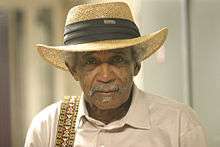Swamp blues
| Swamp blues | |
|---|---|
| Stylistic origins | |
| Cultural origins | 1950s Louisiana, US |
| Typical instruments | |
| Derivative forms | Swamp pop |
Swamp blues, sometimes the Excello sound,[1] is a subgenre of blues music and a variation of Louisiana blues that developed around Baton Rouge in the 1950s and which reached a peak of popularity in the 1960s. It generally has a slow tempo and incorporates influences from other genres of music, particularly the regional styles of zydeco and Cajun music. Its most successful proponents included Slim Harpo and Lightnin' Slim, who enjoyed a number of national rhythm and blues hits and whose work was frequently covered by bands of the British Invasion.
Characteristics

Swamp blues is a laid-back, slow tempo, and generally more rhythmic variation of Louisiana blues, that incorporates influences from New Orleans blues, zydeco, soul music and Cajun music. It is characterized by simple but effective guitar work and is heavily influenced by the boogie patterns used on Jimmy Reed records and the work of Lightnin' Hopkins and Muddy Waters.[2] The sound of swamp blues was characterized by "eerie echo, shuffle beats, tremolo guitars, searing harmonica and sparse percussion".[3]
History
Swamp blues originated in the Louisiana state capital, Baton Rouge, and were particularly associated with record producer J. D. "Jay" Miller.[3] In the 1950s Miller realized many blues artists around the city had not been recorded. He rectified this, distributing their recordings through Excello Records in Nashville, Tennessee.[1] The most successful and influential artist with whom he worked was guitarist and harmonica player Slim Harpo.[4] Other major artists included Lightnin' Slim, Lazy Lester, Silas Hogan, Lonesome Sundown[3] and piano player Katie Webster.[1] A number of their tracks, particularly those of Slim Harpo, were covered by British Invasion bands, including the Rolling Stones, The Kinks and the Yardbirds.[5] The popularity of the genre faded in the 1970s, with many swamp bluesmen turning to zydeco which remained popular with black audiences.[1]
See also
References
- 1 2 3 4 G. Herzhaft, Encyclopedia of the Blues, trans B. Debord (University of Arkansas Press, 2nd ed., 1997), ISBN 1-55728-452-0, pp. 140–4.
- ↑ Cub Coda, "Swamp blues", Allmusic, archived from the original on 30 May 2011.
- 1 2 3 R. Unterberger, S. Hicks and J. Dempsey, Music USA: the Rough Guide (London: Rough Guides, 1999), ISBN 1-85828-421-X, p. 175.
- ↑ Du Noyer, Paul (2003). The Illustrated Encyclopedia of Music (1st ed.). Fulham, London: Flame Tree Publishing. p. 162. ISBN 1-904041-96-5.
- ↑ R. Unterberger, "Louisiana blues", in V. Bogdanov, C. Woodstra, S. T. Erlewine, eds., All Music Guide to the Blues: The Definitive Guide to the Blues (Milwaukee, WI: Backbeat Books, 3rd ed., 2003), ISBN 0-87930-736-6, pp. 687–8.